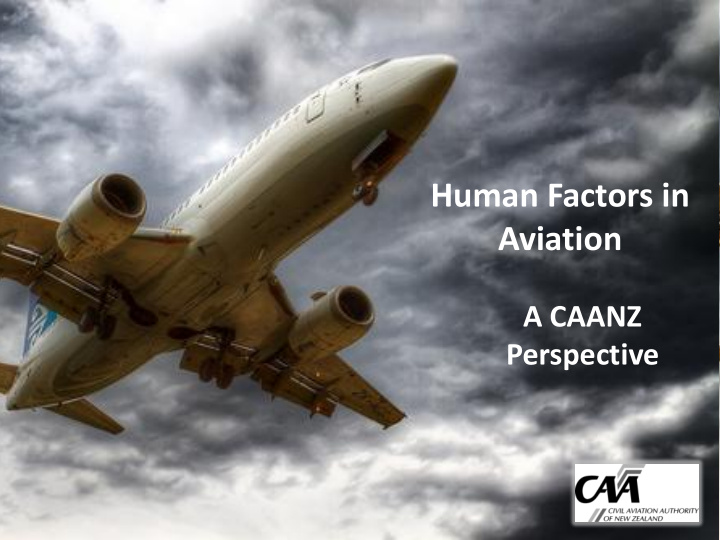



Human Factors in Aviation A CAANZ Perspective
Scope Human Factors • Airline flight operations • Maintenance • Aviation risk • Regulatory approach • SMS • A dynamic industry
Rule Development Part 121 (large aeroplanes) – Crew member training & competency assessment • Rule to be signed this week • Human Factors training • Flight crew and cabin crew • All phases of training • Instructor & Examiner competency (HF) • 2 year transition
Rule Development Part 125 (medium aeroplanes) – Crew member training & competency assessment • Stalled; with MoT o Regulatory Impact Statement o NPRM • Human Factors training (similar req’ts to Part 121) • Use of simulators • Line training safety
Advisory Circular • Final draft completed • Legal review completed • Changes being incorporated (Rule alignment etc.) • 2 year transition period (per Rule) • Changes to crew member training approach • Investment in instructor/examiner training • Implementation guidance • Joint industry – regulator effort • Need for further stakeholder engagement o Airline flight operations seminar 27 September 2012
Maintenance • Part 145 Advisory Circular ‘Human Factors in Maintenance’ in development • Focus is to optimise safety performance and reduce maintenance error • Considerable international guidance available • Some NZ Part 145 organisations have HF programmes; industry input will be sought
CAA Organisational Changes • Appointment of Cabin Safety Inspector • Developing capability in safety analysis unit (Human Factors specialist)
Aviation Risk • Human Factors [breakdowns] have contributed to a large percentage of aircraft accidents • Crew related HF risk factors include: o Lack of situational awareness (SA) o Poor decision making Cognitive skills Flight discipline / deviation from procedures Low risk perception and/or high risk tolerance o Inadequate monitoring o Improper response to abnormal situations • Recent accidents & incidents illustrate these human performance deficiencies still exist
Examples - Accidents AF 447 Spanair 5022
Examples - Incidents • A brief stick shaker event occurred after take-off. At 400 ft the gear was noted as still being down and was raised. At 800 ft it was noted that the flaps were up, and had been inadvertently raised after take-off. • On climb-out passing FL125 stick shaker activation and rapid speed decay upon entering edge of CB with associated turbulence. A/pilot disengaged and standard recovery accomplished.
Examples - Incidents • Pilot failed to set correct QNH on the subscale on descent. Aircraft had been instructed to descend to 8000 ft but came within 300 ft of aircraft maintaining 7000 ft. • A flight crew member fell into a sudden deep sleep while on the flight deck due to fatigue
Examples - Incidents • At 200-300 ft on approach Rwy 23 wind gust generated IAS +20 kts increasing. Go-around carried out. Re-circuit visually for second attempt. Again at 200-300 ft wind gust with same result. Visual reposition over Lake Wakitipu in region of Jardines for approach to Rwy 05. Strong tailwinds at times but stable criteria met throughout for normal landing.
Examples - Incidents • During a transit walkaround the crew found the right hand engine left cowl latches undone. [The aircraft had an oil level check completed at previous departure point] • A burning electrical smell was detected in the rear galley. On checking oven, it was noted that it was bright orange in colour and very hot. Oven was turned off for approximately one hour. Oven was turned on to facilitate continuation of meal service; within 5 -10min the oven fan and surround was orange again. The galley power was switched off and left off.
Examples - Incidents • ARC from pax (ATPL holder). Queenstown, moderate snow, visibility 1 mile, temp 0°. Aircraft taxied for take-off. Snow on wings and pax alerted cabin crew of need to de-ice. Concerns were dismissed. Pax then asked that flight crew be notified. FO inspected wings then Captain gave PA that they were going to continue as no de-icing fluid available. Pax talked to Purser and was adamant that aircraft should not take-off until de-iced, or he wanted off. Aircraft returned to gate. De-icing was completed. Aircraft departed.
Managing risk – operators/pilots • Training o Technical and non-technical (HF/CRM) skills o Resilience • Flight Discipline o Professionalism o Adherence to procedures o Rejecting shortcuts o Planning & preparation
Elements of good performance Kern, 1996
CAA’s Regulatory Approach • Timeliness and responsiveness • Impartiality, fairness, and consistency • Risk-based, proportionate regulatory interventions • Informed, analysis-led and evidence-based decisions • Transparency and trust • Constructive engagement with industry
Regulatory Operating Model
Regulatory response – considerations
SMS Advisory Circular • Accountability for safety o Responsibility vs. accountability o Important role of management o Safety culture • Safety performance indicators o Reactive o Proactive / Predictive o Interactive
A Dynamic Industry Risks
A Dynamic Industry Technology
Final Thoughts From a CAANZ perspective... • Human performance continues to be a major factor in aviation accidents and serious incidents. • Human Factors initiatives can be implemented now • For industry participants, procedures, training (HF), and discipline are key initiatives to reduce risk • Rules / guidance provided by regulator can assist • CAANZ regulatory approach focused on reducing risk, promoting willing compliance with safety standards, and encouraging performance above the minimum standard • Thank you for inviting our participation
Questions?
Recommend
More recommend